Related Research Articles
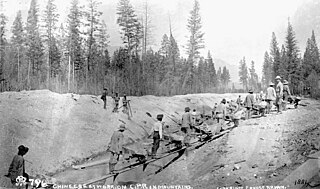
Chinese immigrants began settling in Canada in the 1780s. The major periods of Chinese immigration would take place from 1858 to 1923 and 1947 to the present day, reflecting changes in the Canadian government's immigration policy.

Canuck is a slang term for a Canadian. The origins of the word are uncertain. The term Kanuck is first recorded in 1835 as an Americanism, originally referring to Dutch Canadians or French Canadians. By the 1850s, the spelling with a "C" became predominant. Today, many Canadians and others use Canuck as a mostly affectionate term for any Canadian.
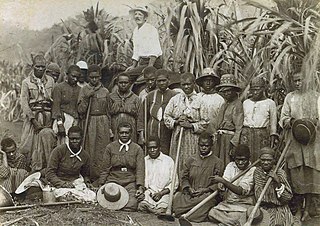
Kanakas were workers from various Pacific Islands employed in British colonies, such as British Columbia (Canada), Fiji, Solomon Islands, Vanuatu, Papua New Guinea, and Queensland (Australia) in the 19th and early 20th centuries. They also worked in California and Chile.
Cultural assimilation is the process in which a minority group or culture comes to resemble a society's majority group or assimilates the values, behaviors, and beliefs of another group whether fully or partially.
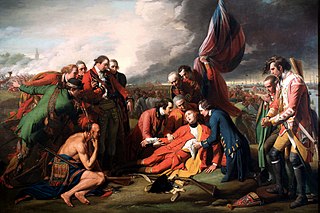
The history of British Columbia covers the period from the arrival of Paleo-Indians thousands of years ago to the present day. Prior to European colonization, the lands encompassing present-day British Columbia were inhabited for millennia by a number of First Nations.
Cultural conservatism is described as the protection of the cultural heritage of a nation state, or of a culture not defined by state boundaries. It is sometimes associated with criticism of multiculturalism, anti-immigration sentiment, and opposition to illegal immigration. Because their cultural preservationist objectives are in conflict with those of anti-racists, cultural conservatives are often accused of racism. Despite this, however, cultural conservatism can be more nuanced in its approach to minority languages and cultures; it is sometimes focused upon heritage language learning or threatened language revitalization, such as of the distinctive local dialect of French in Quebec, Acadian French, Canadian Gaelic, and the Mi'kmaq language in Nova Scotia and New Brunswick, or the Irish language in Newfoundland. Other times cultural conservatism is more focused upon the preservation of an ethnic minority's endangered ancestral culture, such as those of Native Americans.

The Fraser Canyon Gold Rush, began in 1858 after gold was discovered on the Thompson River in British Columbia at its confluence with the Nicoamen River a few miles upstream from the Thompson's confluence with the Fraser River at present-day Lytton. The rush overtook the region around the discovery and was centered on the Fraser Canyon from around Hope and Yale to Pavilion and Fountain, just north of Lillooet.
The demographics of Metro Vancouver indicate a multicultural and multiracial region. Metro Vancouver is a metropolitan area, with its major urban centre being Vancouver, British Columbia, Canada. The Vancouver census metropolitan area, as defined by Statistics Canada, encompasses roughly the same territory as the Metro Vancouver Regional District, a regional district in British Columbia. The regional district includes 23 local authorities. Figures provided here are for the Vancouver census metropolitan area and not for the City of Vancouver.
The history of immigration to Canada details the movement of people to modern-day Canada. The modern Canadian legal regime was founded in 1867, but Canada also has legal and cultural continuity with French and British colonies in North America that go back to the 17th century, and during the colonial era, immigration was a major political and economic issue with Britain and France competing to fill their colonies with loyal settlers. Until then, the land that now makes up Canada was inhabited by many distinct Indigenous peoples for thousands of years. Indigenous peoples contributed significantly to the culture and economy of the early European colonies to which was added several waves of European immigration. More recently, the source of migrants to Canada has shifted away from Europe and towards Asia and Africa. Canada's cultural identity has evolved constantly in tandem with changes in immigration patterns.

Asian Canadians are Canadians who were either born in or can trace their ancestry to the continent of Asia. Canadians with Asian ancestry comprise both the largest and fastest growing group in Canada, after European Canadians, forming approximately 20.2 percent of the Canadian population as of 2021. Most Asian Canadians are concentrated in the urban areas of Southern Ontario, Southwestern British Columbia, Central Alberta, and other large Canadian cities.

The Khalsa Diwan Society Vancouver is a Sikh gurdwara organization in Vancouver, British Columbia, Canada.
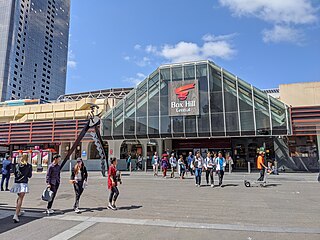
An ethnoburb is a suburban residential and business area with a notable cluster of a particular ethnic minority population, which may or may not be a local majority. That can greatly influence the social geography within the area because of distinct cultural and religious values. Ethnoburbs allow for ethnic minority groups to maintain their traditional identity, forestalling cultural assimilation.

Indo-Canadians or Indian Canadians, are Canadians who have ancestry from India. The term East Indian is sometimes used to avoid confusion with the Indigenous peoples of Canada. Categorically, Indo-Canadians comprise a subgroup of South Asian Canadians which is a further subgroup of Asian Canadians. According to Statistics Canada, Indians are one of the fastest growing communities in Canada and one of the largest non-European ethnic groups.
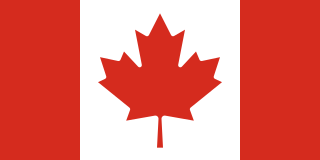
Canadians are people identified with the country of Canada. This connection may be residential, legal, historical or cultural. For most Canadians, many of these connections exist and are collectively the source of their being Canadian.
South Asian Canadians in Metro Vancouver are the third-largest pan-ethnic group in the region, comprising 369,295 persons or 14.2 percent of the total population as of 2021. Sizable communities exist within the city of Vancouver along with the adjoining city of Surrey, which houses one of the world's largest South Asian enclaves.
The history of Chinese Canadians in British Columbia began with the first recorded visit by Chinese people to North America in 1788. Some 30–40 men were employed as shipwrights at Nootka Sound in what is now British Columbia, to build the first European-type vessel in the Pacific Northwest, named the North West America. Large-scale immigration of Chinese began seventy years later with the advent of the Fraser Canyon Gold Rush of 1858. During the gold rush, settlements of Chinese grew in Victoria and New Westminster and the "capital of the Cariboo" Barkerville and numerous other towns, as well as throughout the colony's interior, where many communities were dominantly Chinese. In the 1880s, Chinese labour was contracted to build the Canadian Pacific Railway. Following this, many Chinese began to move eastward, establishing Chinatowns in several of the larger Canadian cities.
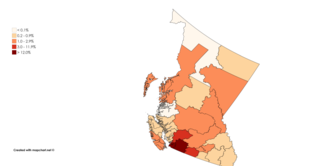
The South Asian community in British Columbia was first established in 1897. The first immigrants originated from Punjab, British India, a northern region and state in modern-day India and Pakistan. Punjabis originally settled in rural British Columbia at the turn of the twentieth century, working in the forestry and agricultural industries.

Sikhism in Greater Vancouver is one of the main religions across the region, especially among the Indo-Canadian population. The Sikh community in Vancouver is the oldest, largest and most influential across Canada, having begun in the late 19th century.

East Asian Canadians are Canadians who were either born in or can trace their ancestry to East Asia. East Asian Canadians are also a subgroup of Asian Canadians. According to Statistics Canada, East Asian Canadians are considered visible minorities and can be further divided by on the basis of both ethnicity and nationality, such as Chinese Canadian, Hong Kong Canadian, Japanese Canadian, Korean Canadian, Mongolian Canadian, Taiwanese Canadian, or Tibetan Canadian, as seen on demi-decadal census data.
An Internment Camp in Vernon, BC was established to hold enemy aliens and POWs during the First World War. Once Canada entered World War I, fears of enemy aliens on the home front began to arise. To combat this, the Canadian Government implemented the War Measures Act which gave them the authority to intern and disenfranchise enemy aliens living in Canada. Approximately 8,500 enemy aliens were interned across Canada, with majority of the 24 camps located around the Rocky Mountains and large population centres in Ontario. Vernon housed the permanent camp in British Columbia, operating from September 18, 1914, to February 20, 1920.
References
- 1 2 Strangers Entertained, Government of British Columbia, 1971
- 1 2 3 4 Pang, Guek-Cheng. Culture Shock! Vancouver. Marshall Cavendish International Asia Pte Ltd, August 15, 2010. ISBN 9814484806, 9789814484800. p. 33.
- ↑ Macdonald, Norbert (University of British Columbia). "Population Growth and Change in Seattle and Vancouver, 1880-1960" (Chapter 16). In: Friesen, J. (editor). Historical Essays on British Columbia (Issue 96 of Carleton library). McGill-Queen's Press (MQUP), 1980. ISBN 0771556942, 9780771556944. Start p. 201. CITED: p. 218.
- ↑ Pang, Guek-Cheng. Culture Shock! Vancouver. Marshall Cavendish International Asia Pte Ltd, August 15, 2010. ISBN 9814484806, 9789814484800. p. 33-34.